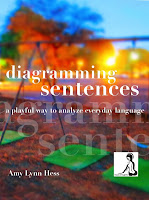![[CC BY 2.0 (http://creativecommons.org/licenses/by/2.0)], via Wikimedia Commons](https://blogger.googleusercontent.com/img/b/R29vZ2xl/AVvXsEjDfvEW9RCQSOS8-M1YdN8Oax8A2mHV1bVErBRtTGgOgWfcSiVHvGR0PC1CK06ijIznpp04R5DKZEjqr1qENGngJPSruVG-wN1EvQpvzjufpid9KszqY04sl_UPQhr8dG81ersKVbgg41o/s640/Slide1.JPG) |
| Independent Clauses for Independence Day By USFWS Mountain-Prairie, Credit: Kate Miyamoto, USFWS (Presentation of the Colors) |
Sentences made up of multiple clauses will be diagrammed on multiple base lines. Let's practice!
Let's practice diagramming multiple base lines by analyzing the following sentence made up of two independent clauses:
"The boys lifted the flag, and the people placed their hands over their hearts and recited the Pledge of Allegiance."
Step One: Identify the Clauses
Picking out Nouns
Let's start by labeling all the nouns. This will help us narrow down which words are used as subjects, objects, or complements.Picking out Verbs
After we pick out the nouns, we should identify all the verbs. Once we identify the nouns and verbs that work together to create kernel sentences, or mini-sentences, we can identify the clauses.In this case, the kernel sentences are "boys lifted," and "people placed and recited." The first clause has a simple subject and predicate. The second clause has a simple subject and a compound predicate.
Both of these clauses are independent clauses because they both contain subjects and verbs and make complete thoughts. The two independent clauses are joined by the coordinating conjunction, "and." One kernel sentence appears before the "and," and the another appears after the "and."
Step Two: Diagramming the Clauses
Diagramming the First Independent Clause
Because there are two clauses in this sentence, we will draw two base lines. The first base line is for the first clause.Diagramming the Coordinating Conjunction
We use the "stair step" dashed line to connect the verb in the first clause with the verb in the second clause. Any of the FANBOYS (for, and, nor, but, or, yet, so) coordinating conjunctions used to connect clauses will be diagrammed on this same type of "stair step" dashed line.Diagramming the Second Independent Clause
We diagram the second clause on the lower base line, adding the conjunction to the compound predicate as we normally would add it, on the straight dashed line linking the two verbs.How'd you do? Please feel free to ask questions in the "Comments" boxes, or take a look at my additional posts, my online classes, or my textbook!
Enjoy!
Want to learn more about diagramming sentences?
My textbook, Diagramming Sentences: A Playful Way to Analyze Everyday Language, is available on Amazon in both ebook and print formats.
Want something more interactive? Preview and enroll in my online video courses on Udemy! Diagramming Sentences: From Beginner to Expert in 12 Lessons.
Copyright Amy Lynn Hess. Please contact the author for permission to republish.








.JPG)


If more than 2 independent clauses are connected in a series by commas and only one coordinating conjunction before the last clause, how do you diagram that? Do you use the stair step and simply leave it blank?
ReplyDeleteYes, absolutely! And if you are keen to do so, you could put the punctuation mark on the line as a reminder or to better study the punctuation of the sentence. I would probably write out the name of the punctuation mark, and put that punctuation in parenthesis just to set them apart: "(Comma)" or "(Em-dash)".
Delete